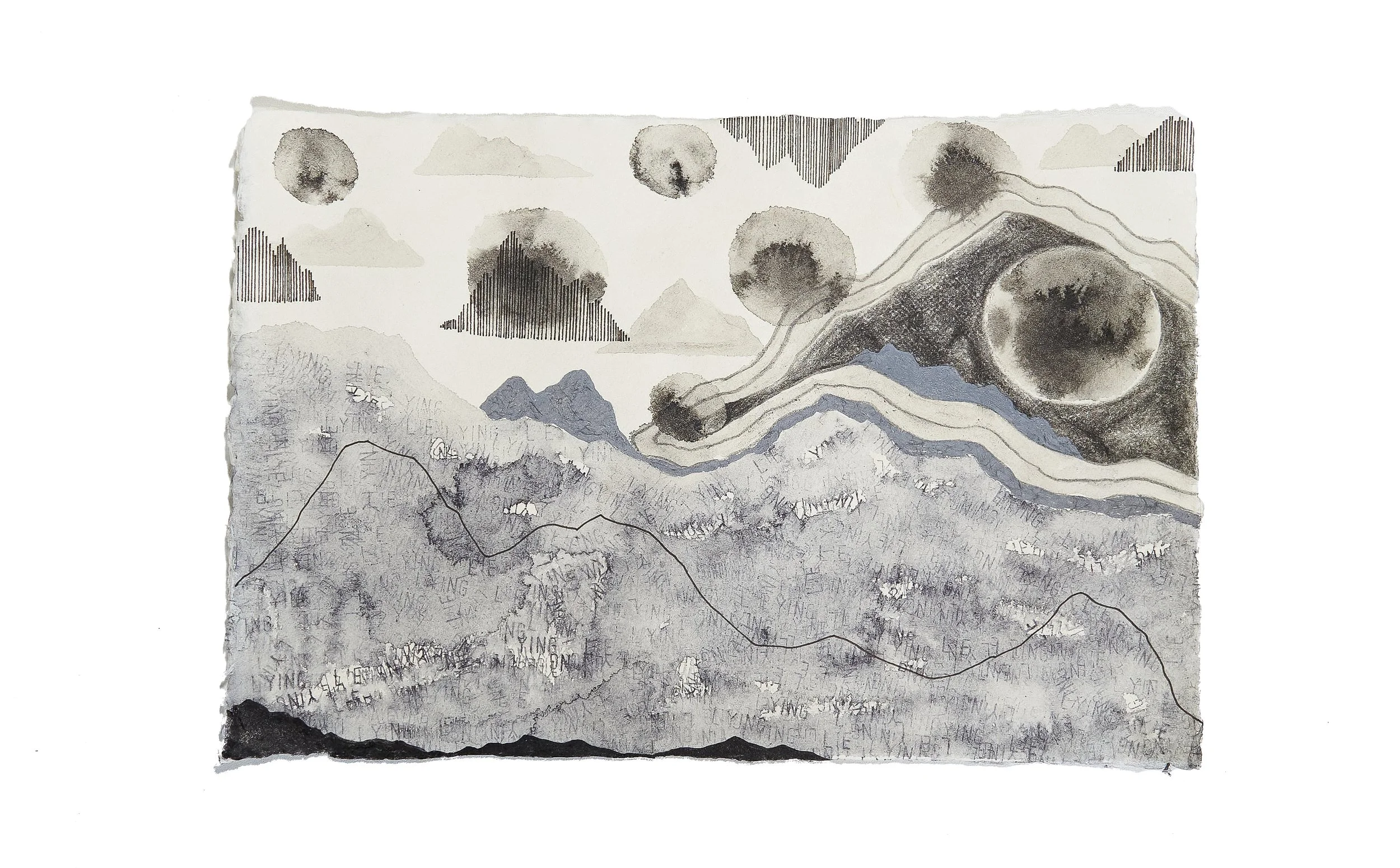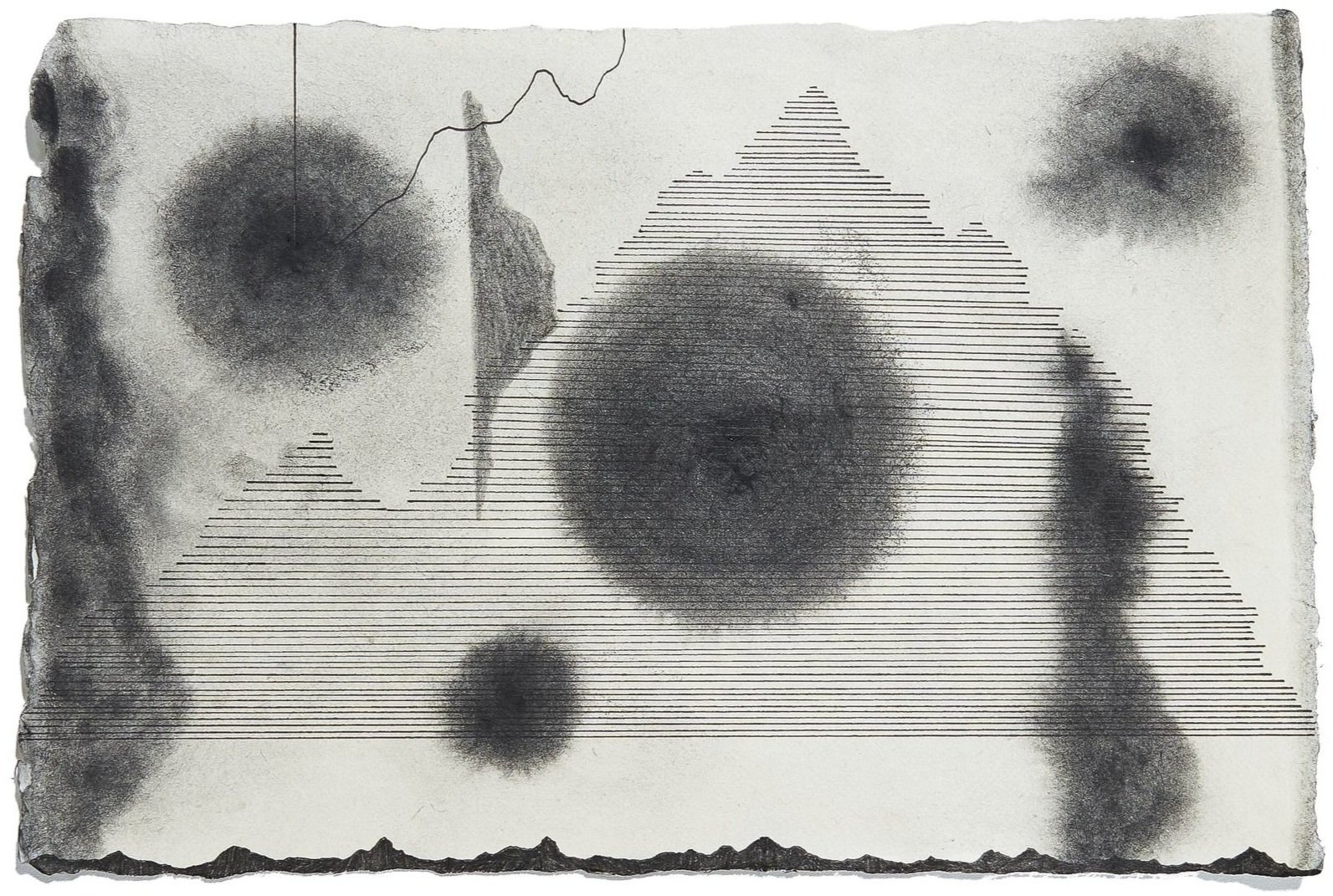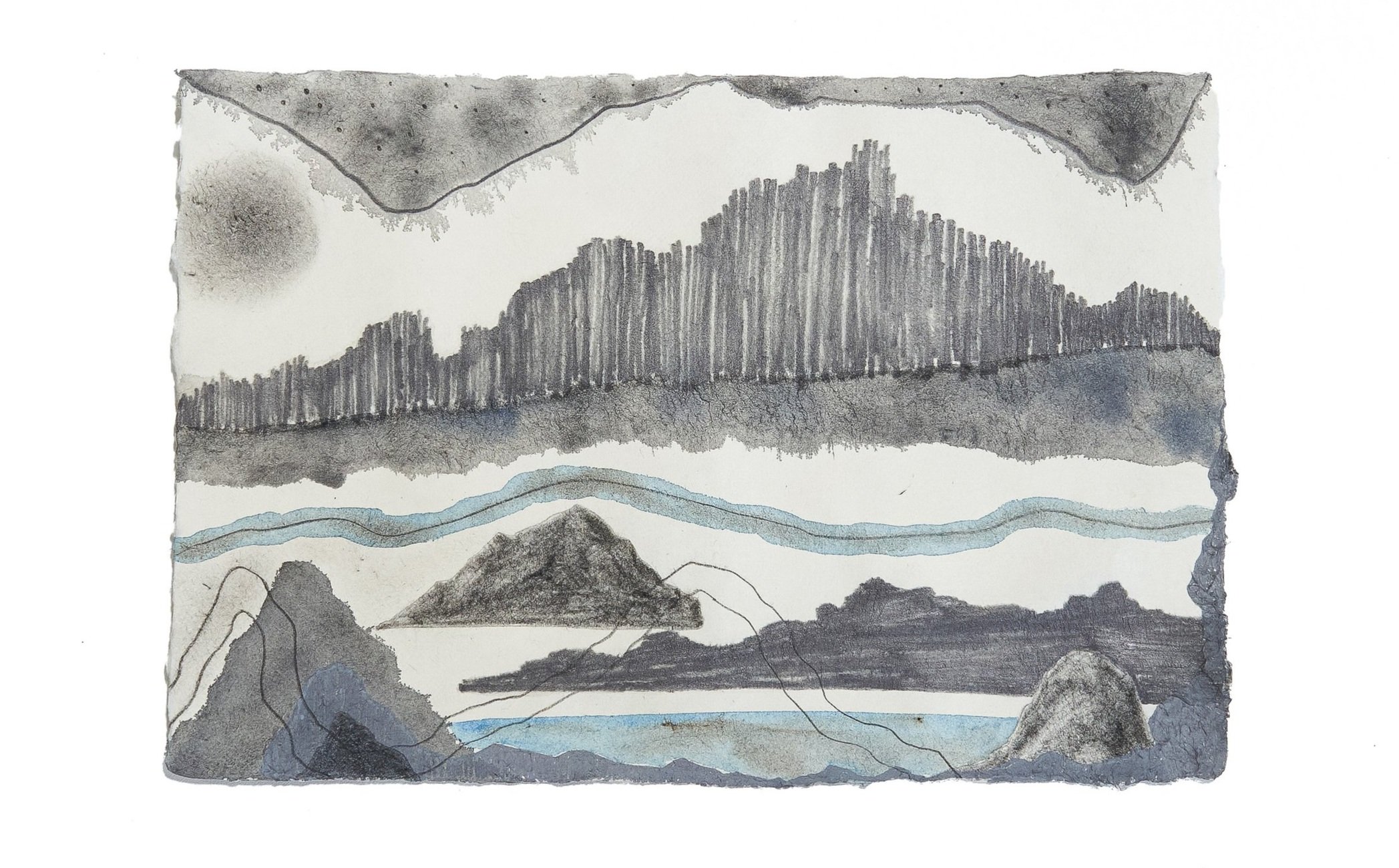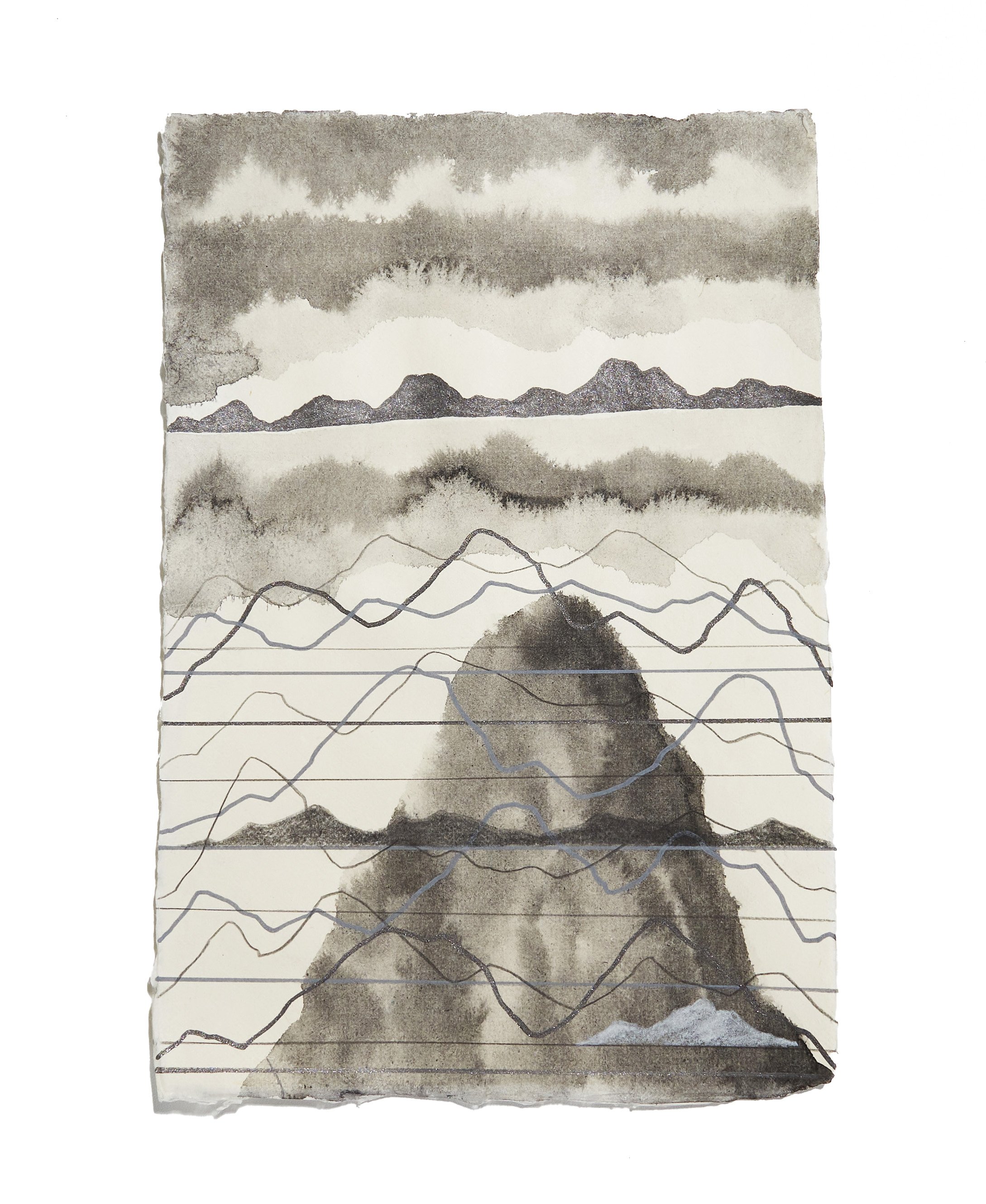Education Resources for Teachers and Students
Surajate Tongchua, Lying Mountain No 14 2023, mixed media drawing on handmade paper, 310 x 210 mm
แผ่นดิน/TANAH/LAND: SURAJATE
TONGCHUA & MARYANTO
Provoking disruption, contemplation,
and a rethinking to how humans
engage with land.
แผ่นดิน/Tanah/Land is a leading example of two contemporary artists engaging with their time and place to critically discuss issues surrounding the landscape. The artworks selected in this education resource bring to the forefront of student enquiry the complex connection contemporaneity has introduced to the relationship between human and land. The artists engage with landscape and place in very different ways. Chiang Mai-based Surajate Tongchua contrasts the massive forms of mountains with ephemeral clouds and freeform linear outlines. Yet, on closer inspection many of the mountains have words collaged onto their bulky slopes, endlessly repeated. An artist with a strong interest in political science and government, Tongchua uses the power of mountains to comment on the doubtful legitimacy of the Thai government. Yogyakarta artist Maryanto uses black scraperboard technique to create large-scale paintings depicting the devastation of the Indonesian landscape wrought by the production of palm oil. Land clearing for palm oil has had a devastating effect on both the landscape and the lives of local agrarian communities. Questions and activities invite students to engage with individual artworks and the exhibition in its entirety, to consider themes that emerge from the artists’ subjective exploration. Students are encouraged to make significant connections between these artists and the wider study of art history.
Scroll down for suggestions and activities for teachers and students.
An Introduction to the Exhibition
แผ่นดิน/Tanah/Land exhibition presents recent works by Surajate Tongchua and Maryanto, two southeast Asian artists whose work critically engages with landscape, the environment and political authority in the region. The works in แผ่นดิน/Tanah/Land show how those in power—government, monarchy, corporations—can be abusive to land. But they also raise important questions: who owns the land? Individual land is owned by individuals, but public land, or land in general? How can it be protected, how can it be cared for, how can it be useful to people equally? Visually, these works convey positive and negative responses. They heighten the collective sense of burden and heaviness but speak with imagery and language which somehow enriches and empowers the viewer.
The exhibition presents the artists’ responses both subjectively and politically, using the land as a source of inspiration, conversation and metaphor to discuss a broader, more than ever present global issue of climate, power, ownership and governing.
Meet the Artists
Surajate Tongchua
Surajate Tongchua (b 1986, Thailand) is currently based in Chiang Mai, Thailand. He graduated from the Department of Print Making, Faculty of Fine Art at Chiang Mai University in 2010. Tongchua’s practice focuses on social power relations that affect state structure (the Organic crisis). Such critical concepts and philosophy of praxis challenge the existing world view, inviting the audience to step away from seeing under the common perception’s filter. Tongchua’s work reflects sharply on the political situation in Thailand by leaving traces of contention in the field of thought.
Tongchua is interested in contemporary art, conceptual art and installation art, resulting in most of his works utilising multimedia and techniques depending on the issues and content expressed. He applies a strategy of incorporating ready-mades or converting the material into another dimension to openly describe current social phenomena.
Maryanto
Maryanto (b 1977, Indonesia) is an Indonesian artist who creates black and white paintings and installations that examine socio-political structures through the depiction of landscapes. His work often explores the impact of technological development, industrialisation, pollution, and resource exploitation on the natural world.
Maryanto graduated from the Faculty of Fine Art, Indonesia Institute of Art, Yogyakarta in 2005, and completed a residency at the Rijksakademie in Amsterdam in 2013. Maryanto has presented solo exhibitions internationally in countries such as Singapore, Hong Kong and Amsterdam. He has also recently participated in notable group exhibitions including the Samstag Museum of Art in Adelaide.
Maryanto works speak to the contemporary conversations that have led to him being featured at international biennials such as the 2nd Industrial Biennale, Labin, Croatia (2018); the Setouchi Triennale, Naoshima, Japan (2016); the Jakarta and Jogja Biennales, Indonesia (2015); and the Moscow Biennale, Moscow, Russia (2013). Maryanto lives and works in Yogyakarta.
Surajate Tongchua (image courtesy of the artist)
Maryanto (image courtesy of the artist and Yeo Workshop)
For Teachers
แผ่นดิน/Tanah/Land presents exciting opportunities to integrate new works by contemporary Southeast Asian artists into existing curricula and case study investigations. The exhibition gives insight into practising artists and how they can use contemporary techniques and methodologies to create artworks that question political and governing structures surrounding the ownership of land, ultimately posing questions to provoke diverse perspectives and an alternative direction. The artists sternly speak to a powerful message and a timely global environmental issue but demonstrate a strong ability to use subtle imagery and mediums to persuade the audience to feel a sense of compassion, agency and empowerment. Individually the artist communicates ideas personal to current land issues to their specific country and culture. Collectively, the exhibition illustrates how artists irrespective of geographical location, show great concern for the land.
Suggestions for Teaching and Learning
Through these lenses students investigate the exhibition to examine artists as truth seekers, risk-takers, environmentalists, and social provocateurs. The artists, in their own rights, use themes and imagery of land, communicating subtle differences in perspective, but with an overall focus on the positive and negative relationship humans seek with the landscape. Material practice such as the use of manipulated objects and a revisitation to traditional media being used in contemporary boundary pushing ways, allows this exhibition to be both beautiful and disrupting. These contemporary methodologies mentioned in these resources are encouraged to be addressed by teachers throughout the study.
A Case Study Example: Art as a Disruptive
Landscape
Students investigate how artists view aspects of the world with divergent perspectives and curiosities, finding connections and conversations between natural and political spheres. Through the artist practice of both Surajate Tongchua and Maryanto, students explore the power of visual metaphor to pose confronting and unresolved questions. They investigate the impact an artist can have when using a personal interest to discuss the link between societal concerns and discover a realm of art and artists that attempt to disrupt and evolve our perception of norms, rules and governing processes. Students can begin by researching relevant art terms to situate Surajate Tongchua and Maryanto’s artist practice. Intertwined through this exhibition is a complex web of social, environmental, political, scientific, and humanitarian discourse that will see class conversation going beyond the art sector and into topics surrounding leadership, geography, activism, and international policies. See vocabulary list for appropriate terminology.
The relationship between the Subjective and Structural Frames are very present in the exhibition, as the artist responds to their world with personal opinion and through material experimentation using the landscape as the linking theme. Examining historical works such as Edvard Munch’s Scream (1893) to critically discuss the expressive use of colour and line in metaphor of Munch’s mental state, but also the newfound research linking Munch’s painting to the phenomenon and global effects of Krakatoa volcano eruption. Additionally, the investigation into Sir Michael Craig-Martin’s The Oak Tree (1973), which antagonistically questions religious norms and extremes will benefit students’ broader understanding of the relationship between art, visual metaphor and disruption of values and expectations humans engage with on a daily level.
For a historical context students should investigate a brief history of landscape in Asian art by examining works such as Hokusai’s The Great Wave Kanagawa (1831) and Gu Kaizhi’s Nymph of the Luo (c. 344-406). This study will help inform students on the traditional techniques of print and mark making derived from the area and used by the exhibiting artists.
Students will then examine the broader contemporary issues pertaining to land, environment, and ownership across Southeast Asia by reading Mankun Liu’s article Confronting land politics at Art Basel Hong Kong (2023). During this lesson, students are encouraged to complete in-depth artist research on one of the artists mentioned in the article, to seek to understand how that artist’s practice is questioning concerns and conditions regarding land in their country.
Students are encouraged to consider the questions introduced in แผ่นดิน/Tanah/Land and debate their perspectives amongst peers:
Who owns lands? Dividing land into categories of public, private, unclaimed, universal.
How can it be protected and how can it be cared for?
How can it be useful to people equally?
Finally, students will unpack curatorial intentions and the power of the exhibition to influence disruption and change by comparing แผ่นดิน/Tanah/Land with two other exhibitions of a similar nature. The Biennale of Sydney 2022 – RĪVUS, curated by José Roca and Yuki Kihara’s Paradise Camp exhibited internationally, firstly at the New Zealand Pavilion Venice Biennale (2022) and currently the Powerhouse Museum, Sydney (2023).
They might also look comparatively at works by artists such as Cai Guo-qiang, El Anatsui, Sokari Douglas Camp, William Kentridge, JR, Ai WeiWei, Agnes Denes, Neak Sophal, Jakkai Siributr, Joydeb Roaja, Ngoc Nau, Yuki Kihara, Eng Ritchanchandy, Prum Ero, Christo and Jeanne-Claude, Olafur Eliasson, Julie Mehretu, and Jonothan Jones.
Teachers are encouraged to adapt this education resource for their curriculum, in and outside NSW. This education kit makes the following connections to:
Visual Arts NSW Stage 6 Syllabus:
Art Criticism/Art History Focus area:
Artist’s Practice: ideas and inspiration/risk-taking and material boundary pushing.
Conceptual Framework: the ways in which the world is communicated through art by the artist
The Frames: Cultural/Structural/Subjective/Postmodern
The genre of Landscape and contemporary practices such as Environmentalist, Naturalist artists.
Marrying of traditional and postmodern material practice
Art Criticism and Art History Outcomes:
Stage 5 Course: 5.7, 5.8, 5.9, 5.10
Stage 6 Year 11: P7, P8, P9
Stage 6 HSC Year 12: H7, H8, H9
International Baccalaureate Diploma Syllabus:
Theoretical Practice
Visual Arts in Context: Students examine artists working in different cultural contexts and seek to understand the limitations and possibilities to discuss historical events through artmaking.
Visual Arts in Methods: Students look at different techniques for making art. Students investigate and compare how and why different techniques have evolved, and the processes involved.
Communicating Visual Arts: Students explore ways of communicating through visual and written means. Students make artistic choices about how to most effectively communicate knowledge and understanding.
Curatorial Practice
Visual Arts in Context: Students develop an informed response to work and exhibitions they have seen and experienced.
Visual Arts in Methods: Students consider the nature of “exhibition” and think about the process of selection and the potential impact of work on different audiences.
The questions provided in this resource may be used for written responses, examination preparation, or for open-ended discussions in the gallery or the classroom.
Pre-visit Questions for Years 9 – 12
Brainstorm how artists can engage with the landscape when art making?
In your own words, define ‘Land’. Push the boundaries of yours and your peers' understanding.
Discuss the rising global environmental, land governing and agricultural problems.
Research the historical contexts of landscapes in southeast Asian art.
An artist practice is more than art making. Discuss this statement.
Does art have the power to disrupt and disturb societal norms and governing policies?
What are the materials and techniques the artists’ use?
Questions for Written Response Years 11 – 12
Frames:
Explain how artists express global concerns in personal ways within the แผ่นดิน/Tanah/Land exhibition.
Explain how the artists in แผ่นดิน/Tanah/Land use simple yet powerful imagery to portray aspects of the world.
Compare how TWO bodies of work communicate narratives through symbolism.
Use the artists from แผ่นดิน/Tanah/Land in your response.
Practice:
Discuss how the materials artists use affect the way their ideas and intentions are communicated.
Discuss this statement with reference to artworks from แผ่นดิน/Tanah/Land.
Analyse the role of the natural world in artmaking practices.
Discuss this statement with reference to artworks from แผ่นดิน/Tanah/Land.
Conceptual Framework:
‘Artists’ interpretations of the world are constrained by their time and place.’
Evaluate this statement with reference to แผ่นดิน/Tanah/Land.
Investigate ways artists have created significant artworks in response to significant world events.
In your answer, refer to specific artists and artworks from แผ่นดิน/Tanah/Land.
Familiarise yourself with these terms and vocabulary:
Art Activism: a dynamic practice combining the creative power of the arts to move us emotionally with the strategic planning of activism necessary to bring about social change.
Agrarianism: a social and political philosophy, perspective that stresses the primacy of family farming, widespread property ownership, and political decentralization. Agrarian ideas are typically justified in terms of how they serve to cultivate moral character and to develop a full and responsible person.
Call to action: an exhortation or stimulus to do something in order to achieve an aim or deal with a problem.
Cede: to give up or surrender land, position or authority.
Conceptual Art: Art for which the idea (or concept) behind the work is more important than the finished art object. https://www.tate.org.uk/art/art-terms/c/conceptual-art
Contention: Heated disagreement, an assertion, especially one maintained in an argument.
Disrupt: Alter or destroy the structure of something by causing radical change through innovation.
Ecological crisis: occurs when changes to the environment of a species or population destabilizes its continued survival.
Environmental Art: Art that addresses social and political issues relating to the natural and urban environment. https://www.tate.org.uk/art/art-terms/e/environmental-art
Intuitive: using or based on what one feels to be true even without conscious reasoning: instinctive.
Psychogeography: Describes the effect of a geographical location on the emotion and behaviours of individuals. https://www.tate.org.uk/art/art-terms/p/psychogeography
Land/Earth Art: Art that is made directly in the landscape, sculpting the land itself into earthworks or making structures in the landscape using natural materials. https://www.tate.org.uk/art/art-terms/l/land-art
Mark Making: refers to the creation of different patterns, lines, textures and shapes through experimentation and to a degree of uncontrolled results.
Ownership: The act, state or right of possessing something.
Useful Links:
https://artark.com.au/blogs/news/friday-essay-land-kinship-and-ownership-of-dreamings
https://www.artsy.net/article/artsy-editorial-10-female-land-artists
https://www.artsy.net/article/artsy-editorial-market-land-art-challenges-collecting-differently
https://www.artsy.net/article/artsy-editorial-10-artists-making-urgent-work-environment
https://www.teenvogue.com/story/what-is-the-land-back-movement
https://www.nytimes.com/2004/02/08/arts/art-the-scream-east-of-krakatoa.html
https://www.tate.org.uk/art/artworks/craig-martin-an-oak-tree-l02262
For Students
Here you will find information and some focus questions about themes within the แผ่นดิน/Tanah/Land exhibition.
About contemporary art
in southeast Asia
Eluding simple definitions or falsely universalising connections between distinct histories and cultures, the art of southeast Asia is vibrant, dynamic and complex, bearing traces of “the rise and fall of kingdoms and empires, and … the historical traces of colonisation and the often-traumatic birth of nations.”1 Artists from Indonesia, Cambodia, Thailand, Myanmar, Laos, the Philippines, Vietnam, Singapore and Malaysia explore local and global themes including personal and national identity and community, cultural knowledge, power, faith and the increasingly urgent impact of humans on fragile ecosystems.
Find out more
https://theartling.com/en/artzine/artist-defined-contemporary-southeast-asian-art
https://www.sothebys.com/en/articles/five-of-the-most-influential-women-artists-from-southeast-asia
https://artradarjournal.com/7-influential-women-artists-from-asia-pacific/
Joan Kee (2011) Introduction Contemporary Southeast Asian Art, Third Text, 25:4, 371-381, DOI: 10.1080/09528822.2011.587681 at https://www.tandfonline.com/doi/pdf/10.1080/09528822.2011.587681
1 “No Country: Contemporary Art for South and Southeast Asia”, Solomon R. Guggenheim Museum and Foundation
Maryanto, Palm Oil in Daily Life 2023, silkscreen print on paper, 510 x 355 mm
Other Education Resources:













